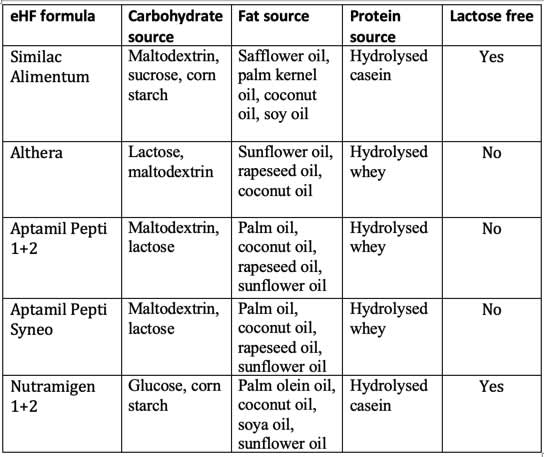In the world of cow’s milk protein allergy, we talk a lot about extensively hydrolysed (eHF) and amino acid formulas (AAF). However, what are these formulas all about and why do we use them?
Cow’s milk protein allergy (CMPA) is the most common food allergy affecting children worldwide. The symptoms can be delayed (non-IgE mediated) or immediate (IgE mediated) or a mixture of both. CMPA may affect a baby who is formula fed, combi fed but also breastfed (dairy can pass through mother’s milk into the baby).
To find out more about CMPA please read on.
First-line treatment – Extensively Hydrolysed Formula (eHF)
Breastfeeding is the best form of nutrition for infants and this should be promoted, supported, and protected wherever possible. However, if breastfeeding isn’t possible or an option, and a child is suspected to have CMPA, guidelines suggest that an eHF is the appropriate first-line choice.
eHF are still made from cow’s milk, however, the allergy-triggering protein has been processed in such a way, making them less allergenic than standard whole cow’s milk formula. Table 1 shows a comparison table of the eHF that are currently on the market.
Table 1: eHF formulas

How about amino acid formulas?
Amino acid formulas (AAFs) are completely milk-free and made up of non-allergenic amino acids also known as the building blocks of a protein. When would an AF be prescribed? Here are some reasons:
- No or little improvement seen on an eHF formula.
- Exclusively breastfed child still struggling severely despite maternal elimination diet
- Severe eczema
- Faltering growth
- Multiple food allergies
- Anaphylaxis
- Severe non-IgE mediated CMPA, e.g. eosinophilic oesophagitis
There is currently 5 AAF available in the UK. Please refer to table 2,
Table 2: AAF

How about breastfeeding mothers?
Dairy can pass from your milk into your baby. You can therefore continue to breastfeed, however, you may need to eliminate dairy from your diet under the supervision of a dietitian. If you are combi feeding, your baby you may require an AAF and not an eHF.
How about soya formulas?
Due to the high incidence of soya sensitivity in infants with CMPA, soya formulas should only be prescribed under supervision by your dietitian or doctor with caution and never under 6 months of age. Up to 60% of children with CMPA also react to soya products.
What should I do if I think my child has CMPA?
Whether you are breastfeeding or formula feeding your baby, I would suggest that you keep a log of all the symptoms your child is showing. This will help your dietitian or doctor to formulate the best plan. Did you know your dietitian can prescribe these formulas also? Get in touch today to learn more.
References
Managing cows’ milk allergy in children doi:10.1136/bmj.f5424
Sardecka I, Łoś-Rycharska E, Ludwig H, Gawryjołek J, Krogulska A. Early risk factors for cow’s milk allergy in children in the first year of life. Allergy Asthma Proc. 2018 Nov 1;39(6):e44-e54. doi: 10.2500/aap.2018.39.4159. PMID: 30401328.
Meyer R, Groetch M, Venter C. When Should Infants with Cow’s Milk Protein Allergy Use an Amino Acid Formula? A Practical Guide. J Allergy Clin Immunol Pract. 2018 Mar-Apr;6(2):383-399. doi: 10.1016/j.jaip.2017.09.003. Epub 2017 Nov 3. PMID: 29109046.




Leave a Comment
You must be logged in to post a comment.